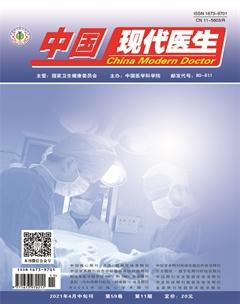俯臥位通氣對海水淹溺型急性呼吸窘迫綜合征大鼠的治療作用
孔敏 徐淼 和秋莉 袁孝忠 周煦燕 徐龍生 楊茂憲
[摘要] 目的 探討俯臥位通氣對海水淹溺所致急性呼吸窘迫綜合征大鼠的治療作用及其機制。 方法 32只雄性SD大鼠隨機分為對照組、ARDS組、仰臥位通氣組(S組)及俯臥位通氣組(P組),每組各8 只。通過氣管內滴注海水4 mL/kg建立ARDS動物模型。對照組、ARDS 組2 h后檢測各指標;S組及P組在ARDS建模后分別進行仰臥位或俯臥位機械通氣2 h后檢測指標。檢測動脈血氧分壓(PaO2)、二氧化碳分壓(PaCO2)、肺濕/干質量(W/D)比值;收集支氣管肺泡灌洗液并測定上清液中蛋白水平;肺組織勻漿后檢測髓過氧化物酶(MPO)及腫瘤壞死因子水平-α(TNF-α)。 結果 與對照組比較,ARDS組、S組、P組PaO2均明顯降低(P<0.05);與S相比較,P組PaO2增高(P<0.05);與P組比較,ARDS組、S組PaCO2 均明顯升高(P<0.05);與ARDS 組比較,S組、P組肺 W/D 比值及BALF中總蛋白含量均明顯降低(P均<0.05);與P 組比較,S組肺 W/D 比值及BALF中蛋白含量均明顯增高(P<0.05),ARDS組及S組肺組織MPO及TNF-α顯著升高(P均<0.05);顯微鏡下,與S組比較,P組塌陷肺泡占比減少,膨脹肺泡占比減少,差異均有統計學意義(P均<0.05)。 結論 俯臥位通氣可改善海水淹溺急性呼吸窘迫綜合征大鼠的通氣功能,減輕肺部炎癥反應。
[關鍵詞] 俯臥位通氣;急性呼吸窘迫綜合征;大鼠;海水淹溺型
[中圖分類號] R714.2? ? ? ? ? [文獻標識碼] A? ? ? ? ? [文章編號] 1673-9701(2021)11-0026-04
Therapeutic efficacy of prone position ventilation on rats with acute respiratory distress syndrome of seawater drowning type
KONG Min1? ?XU Miao1? ?HE Qiuli1? ?YUAN Xiaozhong1? ?ZHOU Xuyan1? ?XU Longsheng2? ?YANG Maoxian3
1.Department of Anesthesiology, Affiliated Hospital of Jiaxing University, Jiaxing? ?314001, China; 2.Central Laboratory, Affiliated Hospital of Jiaxing University, Jiaxing? ?314001, China; 3.Intensive Care Unit, Affiliated Hospital of Jiaxing University, Jiaxing? ?314001, China
[Abstract] Objective To investigate the therapeutic efficacy and mechanism of prone position ventilation on rats with acute respiratory distress syndrome(ARDS) of seawater drowning type. Methods A total of 32 male SD rats were randomLy divided into the control group(n=8), the ARDS group(n=8),the supine ventilation group (the S group, n=8) and the prone ventilation group(the P group, n=8). ARDS animal model was established by intratracheal instillation of seawater with 4 mL/kg. The indexes of the control group and the ARDS group were detected after 2 hours. The indexes of the S group and the P group were detected after 2 hours of mechanical ventilation in supine or prone position after ARDS modeling, respectively. The arterial oxygen partial pressure(PaO2), carbon dioxide partial pressure (PaCO2), and lung wet/dry mass (W/D) ratio were measured. Bronchoalveolar total lavage fluid (BALF) was collected and the protein level in the supernatant was determined.The levels of myeloperoxidase (MPO) and tumor necrosis factor-α (TNF-α) in lung homogenate were detected. Results Compared with the control group, PaO2 in the ARDS group, the S group and the P group decreased significantly(P<0.05). Compared with the S group, PaO2 in the P group increased significantly(P<0.05), and compared with the P group, PaCO2 in the ARDS group and the S group both increased significantly(P<0.05). Compared with the ARDS group, the lung W/D ratio and protein content in BALF of the S group and the P group both decreased significantly(P<0.05). Compared with the P group, the lung W/D ratio and protein content in BALF of the S group both increased significantly(P<0.05), while MPO in lung tissue and TNF-α in the ARDS group and the S group increased significantly(all P<0.05). Under microscope, compared with the S group, the proportion of collapsed alveoli and expanded alveoli in the P group decreased,all with statistically significant differences(P<0.05). Conclusion Prone position ventilation can improve the ventilation function of rats with ARDS after seawater drowning and reduce the inflammatory reaction in lungs.
[Key words] Prone position ventilation; Acute respiratory distress syndrome; Rats; Seawater drowning type
急性呼吸窘迫綜合征(Acute respiratory distress syndrome,ARDS)是由肺外源性和(或)肺內源性引起的以嚴重的低氧血癥和(或)高碳酸血癥為臨床特征的呼吸衰竭[1-2]。目前尚無能夠針對引起該病的病理生理機制,即肺泡毛細血管通透性增加進行治療的方法,主要的治療策略是機械通氣治療,它也可能引起呼吸機相關性肺損傷[3-4]。目前的觀點認為俯臥位通氣聯合肺保護性通氣策略可以作為輕度、中度ARDS的一線救治方法[5-6]。既往研究發現俯臥位通氣可以降低ARDS患者病死率[7-8],但俯臥位通氣治療因海水淹溺引起的ARDS未見報道。海水淹溺后大多數患者容易引起肺泡毛細血管膜損傷,通透性增加,繼發肺水腫,并繼發海水急性呼吸窘迫綜合征(Seawater inhalation induced acute respiratory distress syndrome,SW-ARDS),病死率極高[9-10]。本研究通過復制海水淹溺型ARDS大鼠模型,采用俯臥位通氣對其治療,為防治海水淹溺ARDS提供了新的思路,現報道如下。
1 資料與方法
1.1 實驗動物及分組
雄性Sprague Dawley大鼠,32只,體重200~230 g,購買于南京市青龍山動物繁殖場,動物合格證號:SCXK(蘇)2017-0001。按照隨機數字表方法分為四組:對照組、海水淹溺組(ARDS組)、仰臥位通氣組(S組)、俯臥位通氣組(P組),每組各8只。本研究中實驗動物處置方法符合動物倫理標準。
1.2 實驗材料和試劑
配方海水按照中國國家海洋局第三海洋研究所海洋生化研究室提供的我國東南沿海配方海水,滲透壓1250~1350 mmol/L,pH值 8.20,密度1.05~1.06 kg/L,NaCl 6.518 g/L,MgCl2 2.447 g/L,MgSO4 3.305 g/L,CaCl2 1.41 g/L,KCl 0.725 g/L,NaHC03 0.202 g/L,NaBr 0.083 g/L。i-STAT血氣分析儀(美國),小動物呼吸機(浙江大學醫學儀器廠,DH-150型),二喹啉甲酸(Bicinchoninic acid,BCA)蛋白濃度試劑盒(海門碧云天公司),腫瘤壞死因子-α(Tumor necrosis factor,TNF-α),ELISA試劑盒(武漢博士德生物有限公司),髓過氧化物酶(Myeloperoxidase,MPO)測試盒(南京建成科技公司)、MULTSKAN-MK3酶標儀(德國 Thermo公司),電子內窺鏡(深圳浩特爾電子技術有限公司),Allegnex-22高速離心機(美國Becman公司),氣管插管(中國新航科技有限公司)。
1.3 動物模型
大鼠自由活動,模型制備前12 h禁食,不禁飲。腹腔注射給予戊巴比妥鈉50 mg/kg全身麻醉,將大鼠頭高腳低仰臥固定于操作臺。借助電子內窺鏡暴露聲門,將氣管插管插入大鼠氣管內。抬高操作臺頭側,與水平面呈45°夾角。海水淹溺組、S組、P組3 min內氣管內滴注海水4 mL/kg,并做錐形旋轉,使海水在肺內各葉均勻分布。模型制備參照文獻[11]。
1.4 機械通氣呼吸機設置
1.4.1 各組通氣方式? 對照組為正常大鼠,不進行機械通氣;ARDS組:在ARDS模型建立后不行機械通氣;S組:在ARDS模型建立后,腹腔注射維庫溴銨2 mg/kg使自主呼吸消失,連接小動物呼吸機行仰臥位機械通氣;P組:在ARDS模型建立后,腹腔注射維庫溴銨2 mg/kg使自主呼吸消失,連接小動物呼吸機行俯臥位機械通氣。
1.4.2 呼吸機參數設置? 呼吸機通氣模式為容量控制,潮氣量6 mL/kg,呼吸頻率為60次/min,FiO2 21%,吸氣與呼吸時間比值為1∶2,連續通氣2 h。對照組和ARDS組在模型建立2 h后進行相應指標檢測。S組和P組在機械通氣2 h后再進行相應指標檢測。
1.5 觀察指標
1.5.1 支氣管肺泡灌洗液(Bronchoalveolar lavage fluid,BALF)中蛋白測定? 用4℃生理鹽水灌洗右肺下葉支氣管肺泡3次,依次為2、2、1 mL。回收灌洗液4℃條件下,轉速1500 r/min,離心半徑80 mm,離心10 min,取上清液采用分光光度計測定BALF中總蛋白。
1.5.2 肺組織濕/干質量比? 各組大鼠放血處死后,迅速取出左肺上葉,吸干肺表面水分和血液,電子天平稱其濕重,放置于75℃烤箱中72 h至恒重,再稱干重,用肺濕重除以干重計算肺濕/干重比。
1.5.3 動脈血氣分析? 用1 mL注射器從分離的大鼠股動脈穿刺取1 mL動脈血,檢測動脈血氧分壓和二氧化碳分壓。
1.5.4 肺組織中的MPO活性及TNF-α含量測定? 取出左肺上葉,用4℃生理鹽水溶液清洗肺組織標本表面的血污,稱重,按照質量1∶5的比例將組織在相應質量的生理鹽水溶液中勻漿。組織勻漿在4℃條件下,3000 r/min,離心半徑80 mm,離心15 min后提取上清。分別按照試劑盒提供的步驟,采用ELISA的方法檢測上清液中TNF-α含量、采用化學比色法檢測上清液中MPO的活性。
1.5.5 肺組織病理學評分? 取大鼠右肺中葉,約2 mm厚,10%甲醛溶液固定24 h、脫水、浸蠟包埋、切片、蘇木素-伊紅(Hematoxylin-eosinstaining,HE)染色。2名觀察者在顯微鏡下同時選取10個互不重疊的視野并分別評分后取平均值,當不一致評分時進行復檢,達成最終意見一致。評分標準:肺泡過度膨脹(肺泡管、肺泡囊和肺泡的最大中空弦長>120 μm);肺泡塌陷(肺泡壁折疊、肺泡形狀扭曲)。
1.6 統計學方法
所有數據均采用SPSS 13.0統計軟件處理,計量資料以均數±標準差(x±s)表示,組間比較采用One-way ANOVA分析,多個均數的兩兩比較采用SNK法,P<0.05為差異有統計學意義。
2 結果
2.1 各組大鼠動脈血氧分壓和二氧化碳分壓的變化比較
與對照組比較,ARDS組的PaO2降低,PaCO2升高;S組的PaO2高于ARDS組;P組大鼠PaO2高于ARDS組和S組,P組PaCO2低于ARDS組及S組(P均<0.05)。
2.2 各組大鼠肺W/D,BALF中蛋白含量、肺組織MPO、TNF-α含量的變化比較
ARDS組肺W/D,BALF中總蛋白含量、肺組織MPO、TNF-α含量均較對照組升高;S組肺W/D、BALF中蛋白含量較ARDS組降低;P組肺W/D、BALF中蛋白含量、肺組織MPO、TNF-α含量較S組降低,差異均有統計學意義(P均<0.05)。見表1。
2.3 各組大鼠肺組織病理形態學的變化
ARDS組較對照組塌陷肺泡比例增加,S組較ARDS組塌陷肺泡占比降低,膨脹肺泡占比較ARDS組增加;P組較ARDS組及S組膨脹肺泡及塌陷肺泡占比降低,差異均有統計學意義(P均<0.05)。
3 討論
本研究中,通過氣管內滴注海水構建海水淹溺型大鼠的ARDS模型,觀察海水淹溺導致的ARDS中肺損傷的變化,結果海水淹溺后,肺組織出現炎癥反應,肺泡內炎性細胞增多,肺泡萎陷,肺水腫。通過肺病理組織學改變和動脈血氣分析提示肺損傷存在。采用俯臥位通氣,改善了急性呼吸窘迫綜合征氣體交換,降低肺部炎癥水平,減輕肺水腫。
溺水已逐漸成為世界范圍內最常見的意外死亡原因之一[12]。高滲性海水吸入會引起嚴重的肺水腫,因為局部高通透性會驅使液體從血管進入肺泡和肺組織間隙。這些因素誘發ALI或ARDS。并且,中性粒細胞和巨噬細胞在肺組織中富集,并分泌促炎因子,如NO、COX-2、TNF-α、IL-1抗氧化蛋白(IL-1)和IL-6[13]。此外,肺組織中炎癥細胞的積累導致炎癥反應和氧化應激失衡[14]。過度的炎癥細胞因子和MPO被認為與ARDS的發生密切相關[15]。雖然臨床對ARDS患者采用了多種藥物和治療方法,但均未顯著降低ARDS患者頑固性低氧血癥,行呼吸機通氣治療改善肺氧合仍是目前治療ARDS的重要手段[16]。本研究發現,大鼠海水淹溺模型中,海水吸入增加了肺內含水量,促進了TNF-α的分泌,抑制了肺組織攜氧及氣體交換能力。在給予俯臥位通氣后,較仰臥位通氣肺氧合能力提高,炎性細胞因子降低,肺水腫情況改善。氣體交換和肺水腫的改善可能與俯臥位通氣減輕肺水腫疊加在重力依賴區肺組織壓縮性肺不張以及毛細血管壓迫引起通氣血流比例失調有關[17]。然而,仰臥位通氣也導致肺泡灌洗液中促炎細胞因子的表達增加。這些結果表明,仰臥位通氣較俯臥位通氣可能導致較大的生物傷,并釋放促炎細胞因子。在本研究中,仰臥位通氣中氣體分布不均勻引起局部區域過度膨脹,會拉伸肺泡細胞,進而引發炎癥反應和細胞因子的釋放[18-19]。這種炎癥反應可能誘導中性粒細胞浸潤肺組織和肺泡腔導致髓過氧化物酶增加[20]。本研究俯臥位通氣組與仰臥位通氣組相比,MPO的激活和炎癥細胞因子如TNF-α的分泌均受到明顯抑制。這可能與俯臥位通氣減輕肺泡,改善氣體交換的通氣,改善分泌物引流,降低海水淹溺至肺出血,誘發的氧化應激等有關[21-22]。
本研究采用海水淹溺急性呼吸窘迫綜合征大鼠模型,與臨床上人海水淹溺急性呼吸窘迫綜合征密切相關[23]。目前未提供俯臥位通氣期間實際使用的平臺壓、呼吸系統順應性等呼吸力學指標。因此,在未來的研究中,還應使用適當的、特定的設備和技術來確定俯臥位對這些參數的影響。目前的實驗設計也可用于其他已建立的急性呼吸窘迫綜合征模型,進一步驗證當前的實驗結果。
綜上所述,俯臥位通氣改善海水淹溺急性呼吸窘迫綜合征大鼠的通氣功能,減少肺泡塌陷區域,降低肺水腫和肺部炎癥反應。
[參考文獻]
[1] Jaramillo-Rocha V.Acute respiratory distress syndrome[J].New England Journal of Medicine,2017,377(19):1903-1904.
[2] Fan E,Brodie D,Slutsky AS.Acute respiratory distress syndrome:Advances in diagnosis and treatment[J].Jama,2018,319(7):698-710.
[3] Oba Y,Salzman GA.Ventilation with lower tidal volumes as compared with traditional tidal volumes for acute lung injury and the acute respiratory distress syndrome[J]. New England Journal of Medicine,2000,343(11):813-814.
[4] Anonymous.International consensus conferences in intensive care medicine. Ventilator-associated lung injury in ARDS[J]. Am J Respir Crit Care Med,1999,160(12):1444-1452.
[5] Gaudry S,Tuffet S,Lukaszewicz AC,et al.Prone positioning in acute respiratory distress syndrome after abdominal surgery:A multicenter retrospective study[J]. Annals of Intensive Care,2013,369:979-981.
[6] Baston CM,Coe NB,Guerin C,et al.The cost-effectiveness of interventions to increase utilization of prone positioning for severe acute respiratory distress syndrome[J]. Critical Care Medicine,2019,47(3):e198-e205.
[7] Beitler JR,Shaefi S,Montesi SB,et al. Prone positioning reduces mortality from acute respiratory distress syndrome in the low tidal volume era:A meta-analysis[J].Intensive Care Medicine,2014,40(3):332-341.
[8] 陳緒池,楊倩會.不同通氣策略在ARDS治療中的臨床療效觀察[J].中國現代醫生,2016,53(10):84-88,91.
[9] Wallis BA,Watt K,Franklin RC,et al.Drowning mortality and morbidity rates in children and adolescents 0-19yrs:A population-based study in queensland, australia[J]. Plos One,2015,10(2):e0117 948.
[10] Marik PE.Iatrogenic salt water drowning and the hazards of a high central venous pressure[J]. Annals of Intensive Care,2014,4(1):21.
[11] 高習文,修清玉,王桂芳,等.海水淹溺肺水腫大鼠肺血管通透性變化的觀察[J]. 中華航海醫學與高氣壓醫學雜志,2006,13(2):80-82.
[12] Zhao Y, Ma L, Wang R,et al.3,5,4'-Tri-O-acetylresveratrol attenuates seawater inhalation-induced acute respiratory distress syndrome via thioredoxin 1 pathway[J].Inflammation to Pulmonary Diseases,2018,41(6):3493-3500.
[13] Y Yzz,B Bzz,DQ D-Qxx,et al.Tanshinone IIA attenuates seawater aspiration-induced lung injury by inhibiting macrophage migration inhibitory factor[J] Biological and Pharmaceutical Bulletin,2011,7:1052-1057.
[14] 楊書英,曹書華.急性肺損傷的藥物治療研究進展[J].中國現代醫生,2007,45(17):156-157,159.
[15] Hll H,Dzz D,Bzz B,et al. Superoxide anion, the main species of ROS in the development of ARDS induced by oleic acid[J].Free Radical Research,2004,12:1281-1287.
[16] 周雪,逯峰.不同機械通氣模式治療老年重癥胸部損傷合并急性呼吸窘迫綜合征的臨床效果觀察[J].中國現代醫生,2019,57(35):24-26,30.
[17] 解立信,王穎.呼吸力學指導下的急性呼吸窘迫綜合征個體化機械通氣策略[J].中華醫學雜志,2018,98(34):2703-2705.
[18] Franco V, Massimiliano G, Micol M, et al.Prone position delays the progression of ventilator-induced lung injury in rats:Does lung strain distribution play a role?[J]. Critical Care Medicine,2005,33(2):361-367.
[19] Slutsky AS,Ranieri VM.Ventilator-induced lung injury[J].New England Journal of Medicine,2013,369(22):2126.
[20] Klebanoff SJ.Myeloperoxidase:Friend and foe[J].J Leukoc Biol,2005,77(5):598-625.
[21] Aguirre-Bermeo H,Turella M,Bitondo M,et al.Lung volumes and lung volume recruitment in ARDS:A comparison between supine and prone position[J]. Annals of Intensive Care,2018,8(1):25.
[22] Broccard A,Shapiro RS,Schmitz LL,et al.Prone positioning attenuates and redistributes ventilator-induced lung injury in dogs[J].Critical Care Medicine,2000,28(2):295-303.
[23] Jin F,Li C.Seawater-drowning-induced acute lung injury:From molecular mechanisms to potential treatments[J].Experimental & Therapeutic Medicine,2017,13(6):2591-2598.
(收稿日期:2020-10-24)

